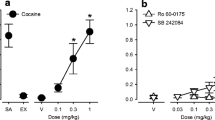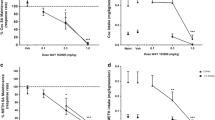Abstract
Cocaine inhibits the reuptake of dopamine (DA), norepinephrine (NE), and serotonin (5-HT). To investigate the relative role of such reuptake processes in the discriminative stimulus properties of cocaine, male rats (N=16) were trained to discriminate cocaine (10 mg/kg) from saline in a two-lever, water-reinforced drug discrimination task and were administered neuroactive compounds during substitution or combination tests. The DA reuptake inhibitor GBR 12909 (2–16 mg/kg) completely mimicked cocaine. The reuptake inhibitors for NE (desipramine; 2–8 mg/kg) and 5-HT (fluoxetine; 0.625–5 mg/kg) did not substitute for the training drug. A low dose of either desipramine (3 mg/kg), fluoxetine (1.25 mg/kg), or GBR 12909 (2 mg/kg) coadministered with low doses of cocaine (0.625–2.5 mg/kg) enhanced the discriminative stimulus properties of this psychostimulant. The dose predicted to elicit 50% drug-lever responding is reduced (ED50) in the presence of desipramine (0.38 mg/kg), fluoxetine (0.79 mg/kg) or GBR 12909 (0.84 mg/kg) compared to the ED50 for cocaine (1.57 mg/kg) in the absence of any reuptake inhibitor. The finding that GBR 12909 mimics the cocaine cue corroborates the hypothesis that the stimulus properties of cocaine are mediated predominantly by DA systems. The potentiation of the stimulus effects of cocaine by monoamine reuptake inhibitors in rats suggests that these drugs could also amplify the subjective effects of cocaine in humans, a possibility that should be considered given the current use of antidepressants in the treatment of cocaine abusers.
Similar content being viewed by others
References
Baldessarini RJ (1990) Drugs and the treatment of psychiatric disorders. In: Gilman AG, Rall TW, Nies AS, Taylor P (eds) Goodman and Gilman's The pharmacological basis of therapeutics. Pergamon, New York, pp 383–435
Barrett RL, Appel JB (1989) Effects of stimulation and blockade of dopamine receptor subtypes on the discriminative stimulus properties of cocaine. Psychopharmacology 99:13–16
Callahan PM, Appel JB, Cunningham KA (1991) Dopamine D1 and D2 mediation of the discriminative stimulus properties ofd-amphetamine and cocaine. Psychopharmacology 103:50–55
Childress A, Ehrman R, McLellan A, O'Brien C (1988) Update on behavioral treatments for substance abuse. In: Harris LS (ed), Problems of drug dependence 1988. National Institute on Drug Abuse Rockville, pp 183–192
Colpaert FC, Niemegeers CJE, Janssen PAJ (1979) Discriminative stimulus properties of cocaine: neuropharmacological characteristics as derived from stimulus generalization experiments. Pharmacol Biochem Behav 10:535–546
Cunningham KA, Appel JB (1982) Discriminative stimulus properties of cocaine and phencyclidine: Similarities in the mechanism of action. In: Colpaert FC, Slanger JL (eds) Drug discrimination: application in CNS pharmacology. Elsevier, Amsterdam, pp 181–192
Cunningham KA, Appel JB (1987) Neuropharmacological reassessment of the discriminative stimulus properties ofd-lysergic acid diethylamide (LSD) Psychopharmacology 91:67–73
Cunningham KA, Dworkin SI, Smith JE (1991) Neurobiology of cocaine: reinforcing and stimulus effects. In: Lakoski JM, Galloway MP, White FJ (eds), Cocaine: pharmacology, physiology and clinical strategies. Telford Press, New Jersey
Fischman MW, Foltin RW, Nestadt G, Pearlson GD (1990) Effects of desipramine maintenance on cocaine self-administration by humans. J Pharmacol Exp Ther 253:760–770
Gawin FH, Kleber HD, Byck R, Rounsaville MD, Kosen RR, Jatlow PI, Morgan C (1989) Desipramine facilitation of initial cocaine abstinence. Arch Gen Psychiatry 46:117–121
Jaffe JH, Witkin JM, Goldberg SR, Katz JL (1989) Potential toxic interactions of cocaine and mazindol. Lancet ii:111
Keppel G (1973) Design and analysis: A researchers handbook. Prentice-Hall, New Jersey
Kleven MS, Anthony EW, Woolverton WL (1990) Pharmacological characteristization of the discriminative stimulus effects of cocaine in rhesus monkeys. J Pharmacol Exp Ther 254:312–317
Koe BK (1976) Molecular geometry of inhibitors of the uptake of catecholamines and serotonin in synaptosomal preparations of rat brain. J Pharmacol Exp Ther 199:649–661
Lamb RJ, Griffiths RR (1990) Self-administration in baboons and the discriminative stimulus effects in rats of bupropion, nomifensine, diclofensine and imipramine. Psychopharmacology 102:183–1990
McKenna ML, Ho BT (1980) The role of dopamine in discriminative stimulus properties of cocaine. Neuropharmacology 19:297–303
Misra AL, Vadlamani NL, Pontani RB (1986) Cocaine-desipramine interaction. Res Commun Subst Abuse 7:85–88
Nunes EV, Rosecan JS (1987) Human neurobiology of cocaine. In: Spitz HI, Rosecan JS (eds) Cocaine abuse: new directions in treatment and research. Brunner/Mazel, New York, pp 48–96
Pollack MH, Rosebaum JF (1987) Management of antidepressant-induced side effects: a practical guide for the clinician. J Clin Psychiatry 48:3–8
Tallarida RJ, Murray RB (1986) Manual of pharmacologic calculations with computer programs, 2nd edn. Springer, Berlin Heidelberg New York
Weiss RD (1988) Relapse to cocaine abuse after initiating desipramine treatment. JAMA 260:2545–2546
Author information
Authors and Affiliations
Rights and permissions
About this article
Cite this article
Cunningham, K.A., Callahan, P.M. Monoamine reuptake inhibitors enhance the discriminative state induced by cocaine in the rat. Psychopharmacology 104, 177–180 (1991). https://doi.org/10.1007/BF02244175
Received:
Accepted:
Issue Date:
DOI: https://doi.org/10.1007/BF02244175




